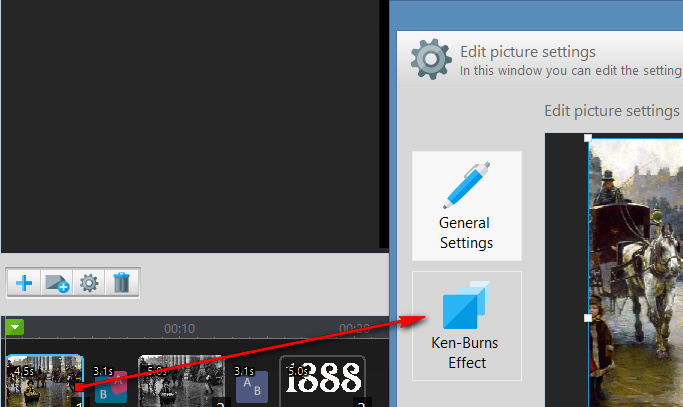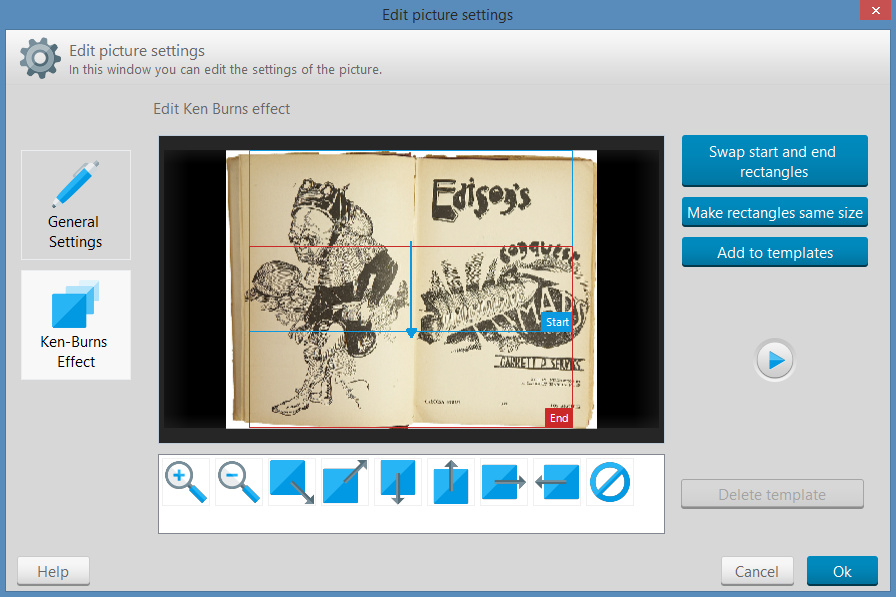I had cause to go looking for a good simple “Ken Burns-style” slideshow software, to make a really simple ‘voiceover documentary with zooming and sliding pictures’. It had to…
* be Windows standalone software, running on Windows back to Win 7.
* be simple, cheap, but up-to-date.
* have ‘Ken Burns style’ transitions, and those should be fully adjustable.
* have fast clear YouTube output, with a small file size for upload over slow broadband.
Surprisingly there’s no such open source software out there, other than some old stuff for Linux. And only a few modern Windows applications that offer Ken Burns style transitions, or at least advertise the fact that they do and use that name.
After my searching and comparing, the German Ashampoo Slideshow Studio HD 4 came top of the small heap in 2016 for standalone Windows software. It’s $40, comes with a whole lot of cheesy transitions and some even cheesier online marketing. But I’ve tried it and it’s very capable and beautifully easy-to-use bit of software, with excellent simple/fast rendering output. It also has the needed Ken Burns style documentary transitions…
So it’s affordable and very useful for rapid production. Slap in your hi-res photos, record a basic voiceover, tweak the transitions, add titles and credits, then output the video. You’re done.
However, you can’t add any sort of video clips and neither can you adjust the audio balance between a music .mp3 and your recorded voiceover. A music .mp3 would thus easily overpower your recorded voiceover and FX, in the final video output. Nor can you boost the amplitude of your voiceover recording, if you have a soft voice. However, one can work around the audio problem, and without having to resort to some huge lumbering video editor.
The complete workflow for making a Ken Burns style slideshow documentary video in Slideshow Studio, without any ‘talking head’ video inserts, would thus be:—
1) Do the research, get the facts straight, and ideally work from the original sources (or as close as you can get). While doing the reading and research, create a list of your likely image-search keywords and phrases.
2) Rough out the voiceover, but only very loosely, just in terms of getting the subject’s basic sub-topics or talking-points in the right order.
3) Then do the intensive picture research, to find the best and most usable hi-res pictures for each of the points you want to address. (On the basis that it’s no use writing a full script and recording the voiceover first, only to find you then can’t get the public-domain or Creative Commons pictures or maps needed for certain sections).
4) Use Slideshow Studio to assemble a simple timed-sequence of your pictures. I’d do this without using the Slideshow Studio wizard, as a wizard-made sequence of slides doesn’t seem to re-flow nicely when you try to add cross-fades between pictures (while also keeping the Ken Burns effects on them).
5) Add titles and credits, and get the picture sequencing absolutely right, so you have the full length of the final video 98% done. (Don’t forget to credit the makers of your Creative Commons pictures, or pictures from museums that offer public domain works. The same goes for texts from the likes of Archive.org and Hathi, and especially short ‘fair use’ quotes found via Google Books).
6) Now preview the sequence in Slideshow Studio while adding a rough and mumbly ‘rehearsal voiceover’, and keep at it until you get the timings right and work out which of your asides and digressions will need to be left out. You’ll see that some pictures will need to be on screen for longer, other for a shorter time.
7) Then, while your finalised sequence of Slideshow Studio slides plays back in preview mode, in another software (such as Audacity) you’ll simultaneously record your final “give it all you’ve got” voiceover. You may want to do this from a script, but a more conversational and impromptu style may flow better and have more bounce. Because you’re recording into an audio editor, rather than Slideshow Studio, there will be less pressure to get the voiceover exactly right and to ‘hit all your marks’ as each slide comes up.
8) In the free Audacity audio editor you’ll then trim away any slight stumbles in your delivery, and boost the depth of your voice (a high squeaky voice, and a recording which opens with a lot of stumbles, may cause your YouTube audience to flee instantly). Then increase the amplitude of the recording, because a ’12 inches from the microphone, with a wind-sock on’ recording will inevitably be too quiet and soft. And a ‘cheap gaming headset, microphone on my top lip’ recording may be too loud and raspy.
You may also want to place a public domain, or SonicFire, music track underneath the trimmed voiceover. Then have it fade in and out, so that your voice can be heard clearly over the music.
The subtle addition of quality sound effects can also work wonders at bringing old photos alive, for instance the faint crackle of a campfire or the sound of a horse, so you may even want a third FX track alongside the voiceover and music.
You can add all these in Slideshow Studio, but the problem is that you can’t mix them or boost their amplitude. Nor can you do that in Ashampoo’s related Movie Studio Pro 2 software. And once you’re into video editors, well… you’re in the ‘video editor hell’ that many creatives will know so well.
9) Once the audio is finished then you can save your voiceover/music mix from Audacity, then output in the form of a single high-quality .mp3 file. Import that into Slideshow Studio as a music file. Now you can finesse the slide timings so everything matches up perfectly.
10) Now — and only now — you can sprinkle your final Ken Burns pan & zoom magic on the pictures. You have the voiceover done, so now you know exactly what the point-of-interest needs to be for each pan & zoom, and when in time that point needs to become dominant on the screen. Slideshow Studio has excellent and easy adjustment tools for the Ken Burns effect.
Output the final video. You now have something of quality to show to potential contributors of talking head video interviews, and if you get enough of those you can take their clips and the Slideshow Studio video to a full video editor, in order to make a longer documentary film.




Pingback: The ‘Ken Burns effect’ and 2.5D for After Effects – 2D digital art and painting